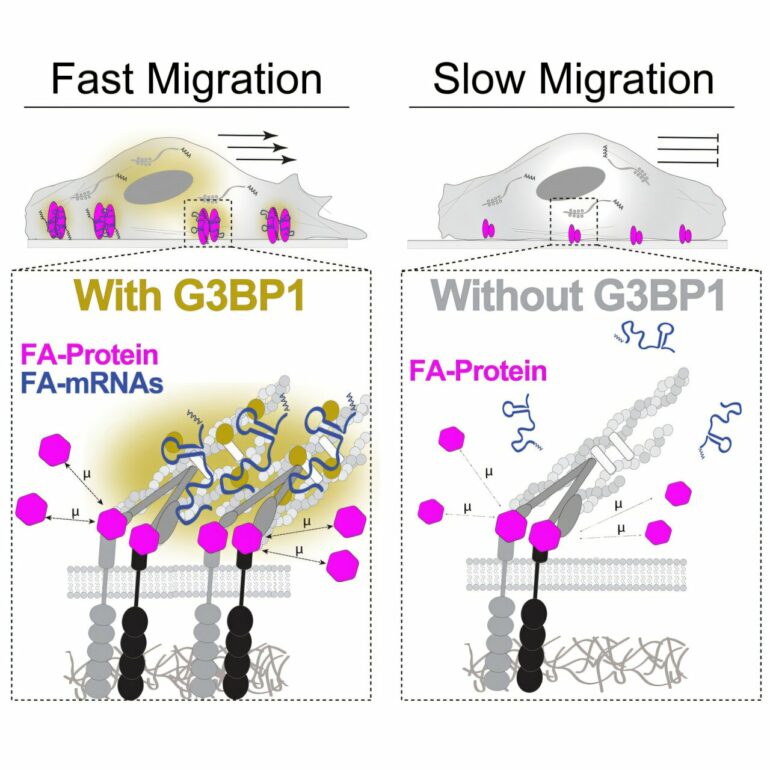Cells in the body have to move around in order to do their jobs. During development, for instance, cells are distributed to create and grow tissue. And in the event of an immune response, different cells are shuttled around. While this process, known as cell migration, is essential for health, it can also go awry and contribute to disease, including chronic inflammation, fibrotic diseases, and cancer metastasis.
Therefore, understanding more about how cells migrate and what molecules are involved may identify targets for treating illnesses in which cell migration falters.
In a new study published recently in the journal Cell Reports, Yale researchers reveal that mRNA, or messenger RNA, plays a significant role in cell migration, a duty that also dramatically expands scientists’ understanding of what mRNA does in the body.
The new finding centers on the “feet” of cells, little bundles of molecules that connect cells to their environment and allow them to “walk” around.
“We’re interested in how the appropriate components interact with the feet of the cell,” said Liana Boraas, an associate research scientist at Yale School of Medicine (YSM) and co-lead author of the study. “How do the cells’ feet get the correct components—like the right ‘socks’ or ‘shoes’—that they need to move appropriately?”
Those socks and shoes are made of proteins, and until now researchers have understood that mRNAs are transported to the feet and help produce those proteins. But it turns out that mRNAs are not just helping make the feet. They’re a component of the feet, part of the socks and shoes themselves, the new findings reveal.
For the study, the researchers first looked for mRNAs at the feet, which are also known as focal adhesions. Previous research had identified a handful of mRNAs that localized around focal adhesions. But Boraas and her colleagues, looking at two different cell types, found 100 to 200 mRNAs at cells’ focal adhesions.
“While mRNAs are usually known for their role in producing proteins, we found this group of mRNAs that are ‘paused’ and not producing proteins at all,” said Stefania Nicoli, an associate professor of internal medicine at YSM and co-senior author of the study.
Rather than producing proteins, these mRNAs were teaming up with a protein called G3BP1 at the focal adhesions. The meeting of the two appears to be necessary for proper cell migration.
“When we removed G3BP1, the cells didn’t migrate as well,” said Boraas. “And changing the mRNA recruited to the focal adhesions also changed how the cells migrated.”
One aspect of cell migration—cell speed—is driven largely by the size of the cells’ feet. The researchers found that the mRNA-G3BP1 complex affected cell migration mainly through its ability to maintain the flow of focal adhesion (foot) proteins, which in turn affected focal adhesion size.
“This finding suggests that mRNAs have hidden functions beyond their usual role in protein production,” said Nicoli. “It’s a discovery that could open up a whole new area of research into how cells work and move—processes that are essential in health and disease.”
The researchers are now investigating whether these findings could be utilized to regulate cell migration, perhaps correcting it when it malfunctions. While current clinical applications of mRNA primarily target its protein-coding function, uncovering its other roles could pave the way for future RNA-based therapies aimed at correcting and/or preventing diseases.
“It’s possible that by introducing different types of mRNA in a localized manner, we could either promote or inhibit cell migration depending on what’s needed in a particular context,” said Boraas.
More information:
Liana C. Boraas et al, G3BP1 ribonucleoprotein complexes regulate focal adhesion protein mobility and cell migration, Cell Reports (2025). DOI: 10.1016/j.celrep.2025.115237
Citation:
Feet first: Understanding how mRNA helps cells ‘walk’ (2025, February 14)



